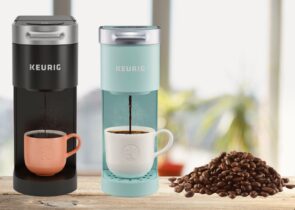Because of the growing popularity of specialty coffee drinks, there is a world of interesting beverages for everyone, from casual coffee drinkers to full-on java experts, to choose from.
Unfortunately, all of that variety can make it difficult to keep up with coffee community trends. Don’t fret, though! We’re here to make sure you have all the information you need to be fully confident in your choice of coffee beans.
Now, if you’ve been keeping your eye on the indie coffee scene lately, you might have seen the term “white coffee” floating around; you may have even seen this cool product on the menu at your favorite hipster coffee shop!
There are countless white coffee descriptions out there, and we’re going to get to the bottom of this java phenomenon once and for all. By the time you’ve finished reading, you’ll be familiar enough with white coffee to fully understand how it compares to the normal coffee you probably drink every morning.

But First, Let’s Clear Up Some Confusion
From North America to Africa, many areas of the world boast some kind of light coffee drink that bears the name “white coffee.” And since no new and creative labels (like “Frappuccino,” for example) have been coined to indicate a white coffee option, things are often left a bit unclear.
Further muddying the waters is the mention of the flat white coffee drink. You can get the full lowdown on this beverage here, but for now, we’ll give you a quick explanation. And no, it’s got nothing to do with the white beans we’re going to dig deeper into later.
The fine cup of coffee known as the flat white is an espresso-based beverage, so it’s usually made with darker roasts, not white coffee beans. After you use your espresso machine to pull a double shot of fresh coffee, pour a helping of steamed milk and a thin layer of microfoam into your cup. There it is, the flat white!
People go for flat whites, or coffee with milk, because the espresso’s rich and full flavor profile is perfectly complemented by the frothy milk. White coffee, on the other hand, is deliberately light and lacks the traditional taste of coffee.
Despite both having the word “white” in their names, the flat white and the white coffee we’re talking about here aren’t the same things. Be sure to keep their distinctions in mind while you peruse the menus at the cafés you often frequent so you don’t get the two confused!
Beginning with Beans
Before we dive deep into the world of white coffee, let’s talk about the type of coffee bean involved. More specifically, let’s talk about the low and not-so-slow roasting process that barely makes it past the first crack and how it leaves the beans with their signature beige color.
Before you order a cup of white coffee, you should know that the brewing method used to make it originated in one of two places: Malaysia or Yemen. While both methods begin with a green coffee bean, they’re both roasted a bit differently.
White coffee roasters have to use a lower roasting temperature than that used to produce medium or dark roast coffee to create this ultra-light roast. The beans are also left in the heat for a significantly shorter time.
The Yemeni white coffee beverage experience begins by roasting beans at an exceptionally low 325 degrees Fahrenheit. As you have probably imagined, they look almost white when removed from the roaster.
Malaysian white coffee, also known as Ipoh white coffee, is very light but not quite white. And, during the roasting process, roasters use palm oil margarine instead of the typical margarine, sugar, and wheat combination used for roasting darker beans. This means that your morning or evening coffee prepared and brewed this way has a slightly caramelized flavor.
More on Malaysian and Yemeni White Coffee
Aside from the slight differences during roasting, there are a few other notable differences in a cup of coffee made from these white beans you should know about.
Preparation
As mentioned above, Malaysian white coffee gets its name from the preparation of the drink itself. After brewing the lightly roasted coffee beans, the barista adds condensed milk to the tan-colored drip coffee.
The ground coffee has to be brewed at about 200 degrees Fahrenheit to make the most of these unique beans’ flavor profile. Then, it’s poured from well above the cup to help the joe cool down and create a nice layer of foam.
The Yemeni version of a white coffee brew is all about the beans, and while they aren’t always served traditionally, many coffee shops that offer it still keep things authentic.
That means a mixture of spices called Hawaij is added to the cup. This aromatic blend is often used for soup, and it includes cinnamon, aniseeds, ginger, cardamom, cloves, and fennel seeds. When Hawaij is involved, the bold coffee flavor so many of us crave is put on the back burner; instead, the focus is on the spiciness of the Hawaij and the sweetness provided by the caramelization and condensed milk.
Taste
Now, if you’re currently at home drinking a potent cup of Death Wish, which combines Arabica and Robusta coffee beans to create a pretty powerful caffeine kick, or you keep a few Indonesian coffees on standby when you need your drip coffee maker to brew something intense, the subtle, less flavorful coffee from Malaysia probably won’t suit you.
The Malaysian brew is perfect when you want to take a break from darker roasts and drink coffee that’s smooth, creamy, and sweet. The coffee flavor is somewhat subdued, though some say it’s purer than coffee muddled by other roasting and extraction processes. But because it’s an even lighter roast, it’ll have a good deal more acidity than most coffees.
However, because of the added spices, Yemeni white coffee has an earthy, nutty taste and none of the bitter flavor notes characteristic of regular coffee. This is a plus for some and a con for others, so personal preference is really the only way to determine whether this is the right coffee beverage for you.
Caffeine Content
Some sources tout the extra caffeine punch white coffee can provide. Supposedly, a long roasting process impacts caffeine levels (more specifically, burnt coffee is less caffeinated), so naturally, the light roasting required for white coffee must mean it has a ton of caffeine. However, this isn’t exactly true.
Because light coffee is denser than dark roasts, measuring your coffee instead of weighing it will give you some slight variation in caffeination. However, the difference isn’t spectacular; the real determiner of caffeine content lies in the beans themselves (like Arabica versus Robusta coffee beans).
So, if you’re not already a fan of white coffee, making the switch from black coffee just for the sake of sipping a more caffeinated brew isn’t worth it. Taking your coffee white isn’t going to outpace taking your regular coffee black, and it probably won’t come close to the kick you’ll get from an espresso shot.
Is white coffee healthy?
If you’re a longtime java drinker and a health enthusiast, you’re probably already familiar with all the benefits of coffee. And while you probably shouldn’t rely solely on white coffee to meet all your health needs, it does boast some excellent benefits.
For starters, this favorite among coffee aficionados is higher in chlorogenic acid than other brews, which already contain considerable amounts of the stuff. Some studies suggest this particular acid might also help improve your cardiovascular health, glucose regulation, weight loss, and more.
No, white coffee is not some magical health elixir, but it certainly has plenty of other benefits that are worth exploring, thanks to that good old chlorogenic acid.
Is it better for you than black coffee?
Because white coffee beans are left on the roaster for a shorter amount of time than their darker counterparts, they retain more chlorogenic acid, which means they’re capable of packing a health boost that’s a bit better than the one that comes from beans that are a dark brown color.
See the difference between white and black coffee here!
How to Drink White Coffee
We’re not going to try to tell you how to take your morning cup. After all, how you enjoy your favorite coffee or espresso beverage is a matter of personal preference. Many people love sipping this stuff sans creamer or sugar, but it’s not uncommon to add a splash of milk to the brew, too. (Pro-tip: if whole milk isn’t your jam, consider pouring some coconut milk into your mug — so good!)
Once you’ve found a good bag of ground white beans, you can also experiment with your favorite flavored syrups (we recommend white chocolate) to find something that blends well with the Hawaij.
There aren’t really any wrong answers when it comes to how you take your white coffee; all that matters is that you love what’s in your cup.
What to Know About White Coffee
Can you make white coffee at home?
Honestly, white coffee isn’t the easiest thing to make from scratch, but it is possible. Chances are, you aren’t going to be able to find a bag of whole beans to purchase. But trust us, these pre-ground products are a blessing, as these beans are relatively dense, making them nearly impossible to grind.
Once you’ve found the lightly roasted beans and you’ve spared your coffee grinder some serious suffering, you’ll need to make sure you have an espresso machine ready to start brewing. Most other brewing methods aren’t going to cut it in terms of how much water they can push through the fine espresso grind you’ll need for a good cup of this stuff.
If you have everything you need for brewing regular espresso on hand, things are pretty straightforward from here. Pull one or two shots of espresso, add condensed milk or Hawaij as appropriate, and enjoy your new favorite at-home beverage.
Is white coffee real coffee?
Yes, white coffee is real coffee! As we mentioned earlier, these are just regular coffee beans roasted for a shorter time at a lower temperature.
Where can you find good white coffee beans?
Now, not every coffee company has white beans on their product roster. But stumbling across batches of the stuff isn’t as difficult as you might think. In fact, you can find bags of these lightly roasted coffee beans on Amazon!
There, you’ll find Poverty Bay White Tornado white coffee roast!
A great place to start your journey into this unique corner of the coffee industry. These shade-grown beans have a delicious and nutty flavor that blends well with all your favorite add-ins, like milk, creamer, or flavored syrups.
Bags of Wired Willey’s and Cafe Appassionato white coffee beans make great gifts for coffee lovers who want to expand their java horizons, too.
Wrapping Up
White coffee, both the Malaysian and Yemeni variety, is an exciting coffee beverage that’s worth trying if you’ve never tasted it. While some of its caffeine boost properties are slightly exaggerated, it is still a tasty treat with a couple of valuable health benefits.
We especially recommend this drink to people who prefer a more subtle coffee flavor and generally prefer lighter roasts. The Malaysian version of white coffee is excellent if you’re looking for something sweet and creamy, where the spice of the Yemeni drink leans into the naturally nutty flavor.
Whichever you choose… Happy Caffeinating!










